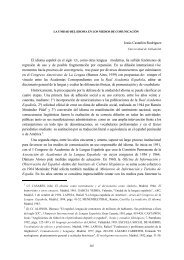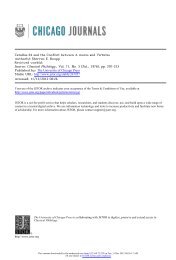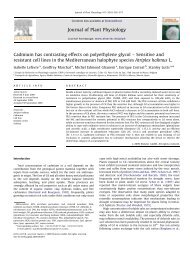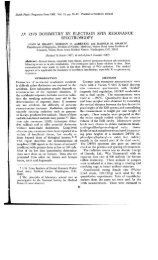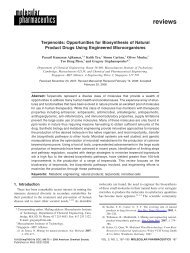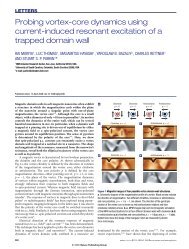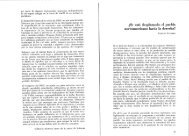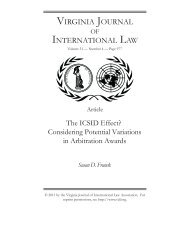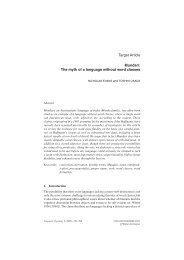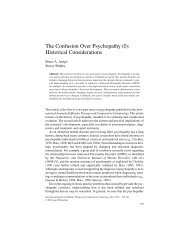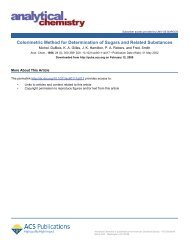Volatile composition of oak and chestnut woods used in brandy ...
Volatile composition of oak and chestnut woods used in brandy ...
Volatile composition of oak and chestnut woods used in brandy ...
Create successful ePaper yourself
Turn your PDF publications into a flip-book with our unique Google optimized e-Paper software.
4-allyl-syr<strong>in</strong>gol were also identified for the first<br />
time.<br />
Some authors reported the presence <strong>of</strong> other phenols,<br />
namely phenol, o-cresol, p-cresol, m-cresol, 4-ethylphenol<br />
<strong>and</strong> methyleugenol (Chatonnet et al., 1989; Nabeta<br />
et al., 1986; Nishimura et al., 1983) but these compounds<br />
were not found <strong>in</strong> our wood extracts.<br />
3.2. Effect <strong>of</strong> wood orig<strong>in</strong><br />
The cooperage <strong>in</strong>dustry needs to have criteria for the<br />
control <strong>of</strong> raw material. Thus, we decided first to compare<br />
the 14 unheated wood samples (7 <strong>woods</strong> · 2 replicates),<br />
<strong>in</strong> order to evaluate the possibility <strong>of</strong><br />
discrim<strong>in</strong>at<strong>in</strong>g the different types <strong>of</strong> wood based on the<br />
levels <strong>of</strong> volatile compounds, <strong>and</strong> after that, we compare<br />
all the wood samples <strong>in</strong> order to evaluate if the wood<br />
discrim<strong>in</strong>at<strong>in</strong>g pattern is <strong>in</strong>fluenced by the toast<strong>in</strong>g<br />
process.<br />
I. Caldeira et al. / Journal <strong>of</strong> Food Eng<strong>in</strong>eer<strong>in</strong>g 76 (2006) 202–211 205<br />
Table 1 <strong>in</strong>cludes the quantitative analysis <strong>of</strong> several<br />
volatile compounds <strong>in</strong> the unheated <strong>woods</strong> <strong>and</strong> the<br />
ANOVA results, whereas Table 2 presents the results<br />
from the analysis <strong>of</strong> all the different types <strong>of</strong> wood<br />
(unheated <strong>and</strong> heated <strong>woods</strong>).<br />
The high st<strong>and</strong>ard deviation <strong>in</strong>dicates the strong variability<br />
<strong>of</strong> the contents <strong>of</strong> these compounds <strong>in</strong> the different<br />
types <strong>of</strong> wood, which is <strong>in</strong> agreement with the results<br />
<strong>of</strong> other authors (Canas et al., 2000; Chatonnet &<br />
Dubourdieu, 1998; Masson et al., 1995; Mosedale &<br />
Savill, 1996; Simon, Conde, Cadahia, & Garcia-Vallejo,<br />
1996).<br />
The ANOVA showed (Table 1) that wood orig<strong>in</strong> had<br />
a very highly significant effect on the quantity <strong>of</strong> cis-bmethyl-c-octalactone<br />
<strong>and</strong> eugenol, a highly significant<br />
effect <strong>in</strong> the levels <strong>of</strong> acetic acid, furfural, 4-hydroxy-2butenoic<br />
acid lactone, hexanoic acid, trans-b-methyl-coctalactone<br />
<strong>and</strong> vanill<strong>in</strong>, <strong>and</strong> a significant effect on the<br />
levels <strong>of</strong> guaiacol.<br />
Table 1<br />
Contents <strong>of</strong> volatile compounds <strong>in</strong> aqueous alcoholic unheated wood extracts <strong>and</strong> wood orig<strong>in</strong> effect (results expressed as lg per g <strong>of</strong> dry wood)<br />
Wood orig<strong>in</strong> effect CNE CNF CNG CAST CFA CFL CAM<br />
Acetic acid ** x 12.22a 67.97d 50.65c 19.09ab 70.20d 13.67a 34.74bc<br />
SD 5.16 0.58 9.61 11.19 6.87 0.54 5.29<br />
Furfural ** x 1.94a 12.51b 4.64a 2.27a 13.63b 4.51a 9.78b<br />
SD 0.67 3.27 0.06 0.81 3.32 1.47 0.28<br />
5-Methyl-furfural n.s. x 0.00 0.28 0.00 0.25 0.77 0.28 0.63<br />
SD 0.00 0.40 0.00 0.35 0.19 0.40 0.31<br />
4-Hydroxy-2-butenoic acid lactone ** x 0.00a 1.27b 0.00a 0.27a 1.50b 0.00a 1.26b<br />
SD 0.00 0.48 0.00 0.39 0.35 0.00 0.43<br />
HMF n.s. x 1.67 2.40 2.70 0.91 0.98 0.26 0.84<br />
SD 1.29 0.43 0.07 0.14 1.38 0.37 0.05<br />
Propanoic acid n.s. x 0.00 0.82 0.36 0.21 0.89 0.00 0.36<br />
SD 0.00 0.04 0.50 0.30 0.40 0.00 0.51<br />
Hexanoic acid ** x 0.64a 8.35b 1.47a 1.16a 8.76b 1.06a 12.52b<br />
SD 0.00 4.27 0.06 0.71 2.21 0.01 2.27<br />
trans-b-Methyl-c-octalactone ** x 2.31bc 2.68bc 2.47bc 0.23a 1.93b 2.87c 2.73bc<br />
SD 0.23 0.79 0.24 0.33 0.06 0.35 0.21<br />
cis-b-Methyl-c-octalactone *** x 6.72a 7.15a 5.30a 0.34a 4.93a 7.18a 35.40b<br />
SD 3.79 3.00 0.67 0.48 0.30 1.39 6.44<br />
Octanoic acid n.s. x 0.75 3.24 2.15 1.41 5.64 1.04 3.92<br />
SD 0.16 2.40 0.74 1.21 1.88 0.09 1.69<br />
Decanoic acid n.s. x 1.60 0.51 2.40 1.42 1.55 1.51 0.87<br />
SD 0.22 0.72 1.70 0.45 0.08 0.78 0.02<br />
Dodecanoic acid n.s. x 2.03 1.56 3.82 0.88 1.01 3.86 1.92<br />
SD 0.01 0.05 2.21 1.24 1.42 0.13 0.50<br />
Guaiacol * x 0.42a 1.25b 0.32a 0.38a 1.19b 0.09a 1.48b<br />
SD 0.25 0.45 0.45 0.26 0.35 0.13 0.02<br />
Eugenol *** x 0.94a 2.69b 1.08a 0.71a 1.17a 1.01a 4.48c<br />
SD 0.02 0.52 0.48 0.06 0.15 0.11 0.33<br />
Syr<strong>in</strong>gol n.s. x 0.39 0.36 0.00 0.53 0.36 0.00 0.00<br />
SD 0.56 0.51 0.00 0.21 0.51 0.00 0.00<br />
4-Allyl-syr<strong>in</strong>gol n.s. x 1.07 0.45 1.40 1.53 0.33 0.66 2.00<br />
SD 0.64 0.63 0.60 0.06 0.47 0.93 1.12<br />
Vanill<strong>in</strong> ** x 4.78bc 4.78bc 5.50c 2.90ab 8.32d 1.21a 5.78c<br />
SD 1.32 0.10 0.56 1.25 0.89 0.29 0.06<br />
Acetovanillone n.s. x 1.89 0.00 0.00 1.28 0.44 0.00 0.91<br />
SD 1.24 0.00 0.00 1.81 0.63 0.00 0.13<br />
x, means <strong>of</strong> two values; SD, st<strong>and</strong>ard deviation; means followed by the same letter <strong>in</strong> a row are not significantly different at the 0.05*, 0.01** or<br />
0.001*** level <strong>of</strong> significance; n.s. without significant difference.



